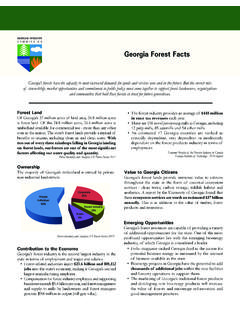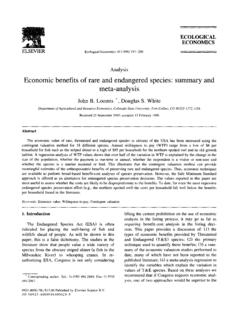Transcription of Executive Summary Introduction Economic Benefits
1 Table of Contents Executive Summary .. 2. Introduction .. 8. Definition of the Forest Industry in Georgia .. 9. Economic Benefits .. 16. Economic Impact of Urban and Community Forestry .. 24. Economic Impact by Regional Commission .. 25. References .. 28. Appendix .. 29. Economic Benefits of the Forest Industry in Georgia: 2016 Page 1. Executive Summary Georgia's forest industry has many components, which interact with all other sectors of the economy in complex ways. The purposes of this analysis are to: (1) quantify the level of Economic activity conducted by the components of the forest industry, (2). estimate Economic activity supported in all Georgia sectors by the industry's activities, (3). compare the level of activity in the forest industry with other industries, and (4) quantify the Economic activity of forest industry sectors within each of the 12 regional commissions in Georgia.
2 This report is the latest in a series that began in 2002, but underwent a significant restructuring in 2003 to reflect the change in industry classification systems from Standard Industrial Classification (SIC) to North American Industry Classification System (NAICS) used by data collection agencies (primarily the Georgia Department of Labor) that provide much of the data used in these analyses. Also, some minor adjustments were made in the 2011 NAICS list to reflect the changes in the new 2012 NAICS code definitions. The forest industry components, and the level of Economic activity represented by them in 2016, are shown in Table E-1. Economic activity is measured by output (similar to sales revenue), employment, and compensation (defined as wages and salaries including Benefits ). These measures are traditionally used in this type of analysis. Table E-1 shows that 51,900 workers were employed in all sectors of the forest industry in 2016.
3 These jobs were paid an annual compensation1 of more than $ billion, and generated an estimated total revenue of nearly $ billion. Table E-1: Georgia Forest Industry Economic Activity (2016). Wages &. Sector Output Employment Salaries Forest Management and Logging $498,649,368 5,920 $294,028,470. Bioenergy $980,982,808 916 $80,044,171. Lumber and Wood Preservation $1,689,889,336 5,520 $317,882,033. Veneer, Plywood, Reconstituted, and $1,435,612,194 4,108 $242,191,339. Engineered Wood Prefabricated Wood Buildings and $379,558,944 1,836 $71,263,603. Manufactured Housing Pulp and Paper Products $13,170,642,672 18,983 $2,023,096,636. Woodworking and Paper Industries Machinery $104,382,613 422 $27,528,390. Wooden Furniture, Cabinets, Custom Arch. &. $1,710,654,931 9,646 $465,800,566. Millwork, Windows and Doors Containers, Showcases, Partitions, and Shelving $824,012,711 4,549 $218,981,932.
4 Total $20,794,385,577 51,900 $3,740,817,140. The industry's activities bring dollars into the state, which recirculate in a process called the multiplier effect. The recirculation touches all major industry sectors as goods and services are bought and sold to meet increased demands by businesses and 1 Wages and salaries including Benefits Economic Benefits of the Forest Industry in Georgia: 2016 Page 2. households resulting from the new resources brought into the state by the forest industry. The result of the multiplier effect, given by total impacts (which includes the Economic activity in Table E-12), is also measured by output, employment, and wages and salaries and is shown in Table E-2. Total Economic activity supported by the forest industry in Georgia (including the multiplier effect and forestry-related bioenergy firms) was $ billion in 2016. These activities supported the employment of 144,537 people whose compensation was $ billion (including Benefits ).
5 Table E-2: Total Benefits by Major Industry (2016). Sector Output Employment Wages & Salaries Agriculture, Forestry, Fish & Hunting $988,713,355 11,826 $567,473,616. Mining $49,289,125 357 $14,405,996. Utilities $1,958,173,172 1,826 $195,932,916. Construction $335,777,365 2,206 $106,634,605. Manufacturing $20,136,539,255 47,055 $3,495,564,794. Wholesale Trade $1,807,689,702 7,016 $611,692,249. Retail Trade $656,521,511 8,289 $263,677,276. Transportation & Warehousing $1,268,885,836 7,335 $437,822,054. Information $797,529,008 1,828 $181,194,268. Finance & Insurance $1,241,544,728 4,833 $340,030,558. Real Estate & Rental $1,557,193,923 4,016 $94,472,113. Professional, Scientific & Tech Services $1,049,797,590 7,959 $574,334,542. Management of Companies $643,253,498 2,706 $322,633,621. Administrative & Waste Services $635,444,703 10,484 $327,284,086. Educational Services $116,755,847 1,644 $67,991,509.
6 Health & Social Services $838,468,888 8,306 $468,577,049. Arts, Entertainment & Recreation $129,082,699 1,996 $46,183,085. Accommodation & Food Services $473,995,085 8,109 $173,216,253. Other Services $548,009,957 6,721 $238,502,524. Government & non-NAICS Industries $4,575,309 25 $1,514,418. TOTAL $35,237,240,556 144,537 $8,529,137,532. Another way to examine forestry in Georgia is to compare it with the state's other manufacturing sectors. Table E-3 lists 2016 employment and income totals for each major manufacturing sector sorted by employment. These data show that forestry ranked second in total employment and first in terms of wages and salaries. Food processing ranked first in employment and second in wages and salaries, and transportation equipment moved up to third in employment and in wages and salaries. 2. The Economic activity in Table E-1 contains more than just the direct impacts because some of the inter- industry purchasing (indirect impacts) is necessarily contained in the estimates of Economic activity.
7 Economic Benefits of the Forest Industry in Georgia: 2016 Page 3. Table E-3: Comparison to Georgia's Other Manufacturing Sectors (2016). Industry Sectors Employment Wages & Salaries Food Processing 66,018 $3,660,164,352. Forest Industry 51,900 $3,740,817,140. Transportation Equipment 51,065 $3,450,170,412. Textiles 50,468 $2,160,676,492. Fabricated Metal Products 36,132 $1,783,132,884. Machinery 23,381 $1,309,273,004. Chemicals 20,338 $1,466,403,016. Printing 13,017 $597,307,256. Electrical Equipment and Appliances 12,889 $977,672,540. Computers and Electronic Products 6,766 $673,992,592. Apparel 2,674 $93,742,584. Of particular importance to Georgia's state government is how forestry affects its annual budget. This is investigated by estimating the revenues associated with the forest industry's total Economic activity and subtracting the costs associated with providing state services to Georgia's households and companies associated with that activity.
8 Revenues include individual and corporate income taxes, sales and use taxes, highway taxes, fees, and miscellaneous revenues. Costs include education; public health, safety, and welfare;. highways; administration; and miscellaneous. Table E-4 provides the fiscal impact estimates based on total impacts. Forestry generated an estimated $778 million in revenues for the state budget in 2016. When the costs of providing services to all employees are deducted from these revenues, net annual state revenues were $345 million for 2016. Table E-4: Fiscal Impact Analysis (2016). Annual State Government Revenues $778,419,307. Annual State Government Costs $433,128,300. Net Annual Revenues $345,291,007. Table E-5 compares the overall results obtained in each impact analysis conducted from 2006 through 2016. Compared to 2015, the industry's 2016 output grew by 8 percent, employment grew by 3 percent, and wages and salaries increased by 5 percent.
9 The industry's increased activity resulted in high net revenues for the state government. Economic Benefits of the Forest Industry in Georgia: 2016 Page 4. Table E-5: Comparison of Results 2006 to 2016. (Dollars in millions; Employment in persons). Forest Industry Direct Economic Impact 2006 2007 2008 2009 2010 2011 2012 2013 2014 2015 2016. Output* $17,760 $18,459 $18,270 $16,906 $14,495 $15,082 $16,072 $16,564 $16,843 $19,203 $20,794. Employment 67,733 64,192 57,812 48,519 43,425 46,378 47,123 48,139 48,740 50,385 51,900. Wages & Salaries* $3,513 $3,394 $3,131 $2,770 $2,624 $2,972 $2,917 $2,938 $3,030 $3,553 $3,741. Year to Year Percent Change Output Employment Wages & Salaries Total Impacts 2006 2007 2008 2009 2010 2011 2012 2013 2014 2015 2016. Output* $27,738 $28,547 $28,723 $27,200 $23,643 $24,975 $27,469 $28,014 $28,674 $32,154 $35,237. Employment 149,347 141,155 128,388 118,423 108,112 118,459 120,260 127,750 129,329 133,256 144,537.
10 Wages & Salaries* $6,773 $6,696 $6,514 $5,561 $5,377 $6,491 $6,540 $6,898 $7,119 $7,860 $8,529. Year to Year Percent Change Output Employment Wages & Salaries Forest Industry Fiscal Impact 2006 2007 2008 2009 2010 2011 2012 2013 2014 2015 2016. State Revenues $580 $566 $539 $472 $448 $487 $691 $700 $721 $753 $778. State Costs $400 $373 $333 $314 $282 $308 $358 $360 $370 $393 $433. Net Revenues* $180 $193 $206 $158 $166 $179 $333 $340 $351 $360 $345. Source: Enterprise Innovation Institute (EI2) impact assessments and Georgia Department of Labor, Current Employment and Wages *Output, Wages and Salaries and Revenues are not adjusted for inflation Economic Benefits of the Forest Industry in Georgia: 2016 Page 5. Impact by Region Quantifying the Economic Benefits of the forest industry at the local level is difficult given the limitations in employment and wages and salaries data (non-disclosed data).











